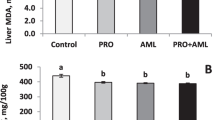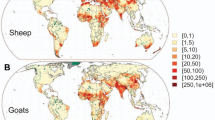Abstract
This study aimed to investigate the milk production potential and the impact of nongenetic factors on milk yield and composition of Tunisian dromedary camels. Milk recording and sampling were carried out at monthly intervals over complete lactation for 3 years from 95 camels reared in intensive and semi-intensive systems. The overall means of daily milk yield and fat, protein, total solids, and ash contents were 4.21 ± 1.98 l/day, 2.45 ± 0.9%, 2.67 ± 0.74%, 10.75 ± 1.41%, and 0.85 ± 0.08%, respectively. The total milk yield was 1388.41 ± 575.46 l/lactation for 11 months of lactation. The daily milk yield increased regularly throughout lactation until it reached its peak in the 4th month postpartum and then decreased until the 17th month postpartum. The chemical components, except ash, followed an opposite trend to the milk yield. Their minimum contents were recorded during the 7th and 8th months postpartum, while the maximum levels were observed during the 17th month postpartum. Regarding seasonal variation, the highest daily milk yield was recorded during summer (June), whereas the lowest was found in winter (December). In contrast, the maximum and minimum contents of fat and protein were observed during winter (December) and summer (July), respectively. Similarly, total solids content was maximum in January and minimum in August. Parity had no effect on daily milk yield, while all chemical components were higher in milk from primiparous than multiparous camels. Calf sex and management system did not affect the milk yield and composition. These results are useful in order to develop feeding strategies and breeding programs for improving milk production.


Similar content being viewed by others
References
Abdalla, E.B., Ashmawy, A.E.-H.A., Farouk, M.H., Salama, O.A.E.-R., Khalil, F.A. and Seioudy, A.F., 2015. Milk production potential in Maghrebi she-camels. Small Ruminant Research, 123, 129–135.
Ahmad, S., Yaqoob, M., Bilal, M.Q., Khan, M.K., Muhammad, G., Yang, L.G. and Tariq, M., 2012. Factors affecting yield and composition of camel milk kept under desert conditions of central Punjab, Pakistan. Tropical Animal Health and Production, 44, 1403–1410.
Al Kanhal, H.A., 2010. Compositional, technological and nutritional aspects of dromedary camel milk. International Dairy Journal, 20, 811–821.
Aljumaah, R.S., Almutairi, F.F., Ismail, E., Alshaikh, M.A., Sami, A. and Ayadi, M., 2012.Effects of production system, breed, parity and stage of lactation on milk composition of dromedary camels in Saudi Arabia. Journal of Animal and Veterinary Advances, 11, 141–147.
Al-Saiady, M.Y., Mogawer, H.H., Faye, B., Al-Mutairi, S.E., Bengoumi, M., Musaad, A. and Gar-Elnaby, A., 2012. Some factors affecting dairy she-camel performance. Emirates Journal of Food and Agriculture, 24, 85–92.
Al-Sultan, S.I. and Mohammed, A.M., 2007.The effects of the number of lactations on the chemical composition of camel milk. Journal of Camel Practice and Research, 14, 61–63.
Atigui, M., Hammadi, M., Barmat, A., Farhat, M., Khorchani, T. and Marnet, P.G., 2014. First description of milk flow traits in Tunisian dairy dromedary camels under an intensive farming system. Journal of Dairy Research, 81, 173–182.
Ayadi, M., Hammadi, M., Casals, R., Atigui, M., Khorchani, T., Samara, E.M., Abdoun, K.A., Al-Haidary, A.A. and Caja, G., 2018. Influence of management type and stage of lactation on the performance and milk fatty acid profile of dairy camels (Camelus dromedaries). The Journal of Agricultural Science, 156, 1111–1122.
Babiker, W.I. and El-Zubeir, I.E., 2014. Impact of husbandry, stages of lactation and parity number on milk yield and chemical composition of dromedary camel milk. Emirates Journal of Food and Agriculture, 333–341.
Bakheit, S.A., Majid, A.M. and Nikhala, A.M., 2008. Camels (Camelus dromedarius) under pastoral systems in North Kordofan, Sudan: Seasonal and parity effects on milk composition. Journal of Camelid Science, 1, 32–36.
Bekele, T., Zeleke, M. and Baars, R.M.T., 2002.Milk production performance of the one humped camel (Camelus dromedarius) under pastoral management in semi-arid eastern Ethiopia. Livestock Production Science, 76, 37–44.
Boutinaud, M. and Guinard-Flament, J., 2004. The number and activity of mammary epithelial cells, determining factors for milk production. Reproduction Nutrition Development, 44, 499–508.
Chegini, A., Zadeh, N.G.H. and Moghadam, H.H., 2015. Effect of calf sex on some productive, reproductive and health traits in Holstein cows. Spanish Journal of Agricultural Research, 13, 2.
El-Hatmi, H., Khorchani, T., Abdennebi, M., Hammadi, M. and Attia, H., 2004. Effects of diet supplementation on camel milk during the whole lactation under Tunisian arid range conditions. Journal of Camel Practice and Research,11, 147–152.
Elobied, A.A., Osman, A.M., Kashwa, S.M.A., Ali, A.S., Ibrahim, M.T. and Salih, M.M., 2015. Effect of parity and breed on some physico-chemical components of Sudanese camel milk. Research Opinions in Animal and Veterinary Sciences, 5, 20–24.
FAO., 2017. http://www.fao.org/faostat/fr/#data/QA. Accessed 17 July 2019.
Faye, B., 2016. The camel, new challenges for a sustainable development. Tropical Animal Health Production, 48, 689–692.
Gillespie, A. V., Ehrlich, J. L., and Grove-White, D. H., 2017. Effect of calf gender on milk yield and fatty acid content in holstein dairy cows. PloS one, 12, 1.
Græsbøll, K., Kirkeby, C., Nielsen, S.S. and Christiansen, L.E., 2015. Danish Holsteins favor bull offspring: biased milk production as a function of fetal sex, and calving difficulty. PloS one, 10, e0124051.
Haddadin, M.S., Gammoh, S.I. and Robinson, R.K., 2008. Seasonal variations in the chemical composition of camel milk in Jordan. Journal of Dairy Research, 75, 8–12.
Hadef, L., Aggad, H., Hamad, B. and Saied, M., 2018.Study of yield and composition of camel milk in Algeria. Scientific Study & Research. Chemistry & Chemical Engineering, Biotechnology, Food Industry, 19, 1–11.
Hamed, H., El Feki, A., & Gargouri, A., 2017. Influence of Wet and Dry Season on Milk Composition of Dromedary Camels (Camelus dromedarius) from Tunisia. Iranian Journal of Applied Animal Science, 7, 163–167.
Hammadi, M., Khorchani, T., Seddik, M.M., El-Hatmi, H., Sghaier M., Barmat A., Fatnassi, B., and Ben Belgacem, A., 2006. Dairy potential of Maghrabi camel in intensive breeding system. 1st Conference International Society of Camelid Research and Development (ISOCARD), Al-Ain, United Arab Emirates, 133.
Hinde, K., Carpenter, A.J., Clay, J.S. and Bradford, B.J., 2014. Holsteins favor heifers, not bulls: biased milk production programmed during pregnancy as a function of fetal sex. PloS one, 9, e86169
Kamoun, M., 1995. Le lait de dromadaire: production, aspects qualitatifs et aptitude à la transformation. Options méditerranéennes, Séries séminaires, 13, 81–103.
Kamoun, M., and Jemmali, B., (2012). Milk yield and characteristics of Tunisian camel. Journal of Animal Science, 1, 12-13.
Khanna N.D., 1986. Camel as a milk animal. Indian farming, 36, 39–40.
Konuspayeva, G., Faye, B. and Loiseau, G., 2009. The composition of camel milk: a meta-analysis of the literature data. Journal of Food Composition and Analysis, 22, 95–101.
Konuspayeva, G., Faye, B., Loiseau, G., Narmuratova, M., Ivashchenko, A., Meldebekova, A. and Davletov, S., 2010. Physiological change in camel milk composition (Camelus dromedarius). Effect of lactation stage. Tropical Animal Health Production, 42, 495–499.
Minick, J.A., Buchanan, D.S. and Rupert, S.D., 2001.Milk production of crossbred daughters of high-and low-milk EPD Angus and Hereford bulls. Journal of Animal Science, 79, 1386–1393.
Moslah, A., 1998. La production laitière du dromadaire en Tunisie. Colloque de Nouakchott, Mauritanie, 1994 (CIRAD, Montpellier, France), 61–65.
Musa, H.H., Shuiep, E.S., Ibtisam, E.M. and Chen, G.H., 2006. Some reproductive and productive traits of camel (Camelus dromedarius) in Western Sudan. Journal of Animal and Veterinary Advances, 5, 590–592
Musaad, A., Faye, B. and Nikhela, A.A., 2013a. Lactation curves of dairy camels in an intensive system. Tropical Animal Health and Production, 45, 1039–1046.
Musaad, A.M., Faye, B. and Al-Mutairi, S.E., 2013b. Seasonal and physiological variation of gross composition of camel milk in Saudi Arabia. Emirates Journal of Food and Agriculture, 25, 618–624.
Nagy, P., 2016. 0918 Camel milk from commodity to added value product. The science behind the development of the camel dairy industry. Journal of Animal Science, 94, 442–442.
Nagy, P. and Juhasz, J., 2016. Review of present knowledge on machine milking and intensive milk production in dromedary camels and future challenges. Tropical Animal Health and Production, 48, 915–926.
Nagy, P., Fábri, Z.N., Varga, L., Reiczigel, J. and Juhász, J., 2017. Effect of genetic and nongenetic factors on chemical composition of individual milk samples from dromedary camels (Camelus dromedarius) under intensive management. Journal of Dairy Science, 100, 8680–8693.
Skidmore, J. A.. 2011. Reproductive physiology in female old world camelids. Animal Reproduction Science, 124, 148–154.
Zeleke, Z., 2007. Non-genetic factors affecting milk yield and milk composition of traditionally managed camels (Camelus dromedarius) in Eastern Ethiopia. Livestock Research for Rural Development, 19, 6. http://www.lrrd.org/lrrd19/6/zele19085.htm Accessed 17 July 2019
Acknowledgments
The authors would like to express their gratitude to the farmers for their help to complete the experimental work.
Funding
This work was supported by the Arid Lands Institute, Medenine, and the Ministry of Higher Education and Research, Tunisia.
Author information
Authors and Affiliations
Corresponding author
Ethics declarations
Conflict of interest
The authors declare that they have no conflict of interest.
Statement of animal rights
All national guidelines for the care and use of animals were followed.
Additional information
Publisher’s note
Springer Nature remains neutral with regard to jurisdictional claims in published maps and institutional affiliations.
Rights and permissions
About this article
Cite this article
Chamekh, L., Khorchani, T., Dbara, M. et al. Factors affecting milk yield and composition of Tunisian camels (Camelus dromedarius) over complete lactation. Trop Anim Health Prod 52, 3187–3194 (2020). https://doi.org/10.1007/s11250-020-02344-0
Received:
Accepted:
Published:
Issue Date:
DOI: https://doi.org/10.1007/s11250-020-02344-0




